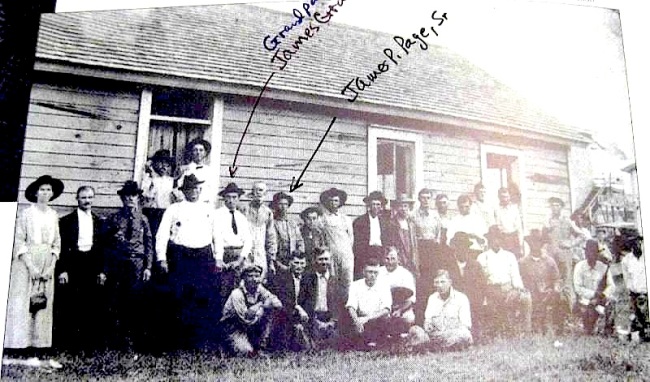If you’ve never heard of dasheen, don’t feel like the Lone Ranger; I hadn’t either. My daughter, Colleen, is the historian of our family and is always finding, archiving and annotating old family photos. Here’s one she found from 1923, showing my grandfather, James P. Page, Sr., and his dad, James Graham Page, at a meeting of the Nassau County (Florida) Dasheen Growers Association in the little town of Callahan:
My grandfather and his father were very active in that organization, or at least they had leadership roles. My grandfather was a heck of a businessman, and owned a lot of businesses that did well. I can’t say how well he and his dad did with dasheen; it put some of his land holdings to productive use, I suppose.
According to what I’ve been able to find out on the Net, dasheen is another term for a type of taro root, and, in the early 1920s, the Florida Secretary of Agriculture was promoting the cultivation of this plant for areas of Florida with boggy land not suited for growing much else except snakes (this part of Florida has 31 types, including six or seven “hot” ones, as the herpetologists call venomous snakes), alligators and pine trees. Here’s a Google satellite photo pinpointing the town of Callahan in Nassau County; my brother, Jeff, and I were born on Amelia Island, where the town of Fernandina Beach is located:

The red arrow points to Callahan, Florida. The dark area to the left of Callahan is the Okefenokee Swamp. The Okefenokee is the largest blackwater swamp in the U.S.; a shallow, 438,000 acre, peat-filled wetland straddling the Georgia–Florida border. Okefenokee is an Indian word meaning “trembling earth.”
Since the area our family is from borders the Okefenokee Swamp that hugs the Georgia line, it’s ideal for such an effort. Here’s a photo of a dasheen plant, and also a photo of the edible root.
This enterprise probably didn’t amount to much, but it’s kind of a nifty idea. Another Net resource mentions that at the height of the dasheen-growing effort, ten boxcar loads of the roots were shipped from Callahan, where we still have a family farm. I don’t think any dasheen is grown on our farm now, though I did see that someone else has a dasheen farm in the area nowadays. Good luck to them!
UPDATE:
Thanks to my daughter, Colleen, for finding the letterhead below from the Dasheen Growers Association in a history of Nassau County. There’s also a little paragraph describing the operation. You can see from the annotations that the photo above, showing the intrepid dasheen growers in Callahan, was from this same book, which was published some years ago.





Sep 19, 2013 @ 23:37:43
Kinda looks like a cleaned up version of the yucca root. I know from living in Costa Rica the yucca is treated just like a vegetable, their potato. They are sliced like fries and fried also. Although that is where the comparison ends, since neither plant looks like each other or is grown in the same conditions. You should try frying some up and let us know.
Sep 19, 2013 @ 23:43:34
Hey, Dave! I’m not a cook and live in the Washington, DC, area nowadays. I had a taro-root dessert at my favorite Thai restaurant last week and it was delicious. Kind of like a grainy tapioca.
–Jim
Feb 26, 2017 @ 10:08:36
in 1923 most of the dasheen growers in Nassau County. Fla., united to organize and incorporate the Nassau County Dasheen Growers’ Association, which name later was changed to the Nassau County Dasheen Growers, Inc. The purpose of organization was to effect better grading of the dasheens marketed, thereby entitling the producers to better prices and to secure the latter by orderly marketing. This brief outline of the development of the industry would be incomplete without mention of three of the farmers most active in forming the cooperative. These were Rudolf W. Froitzheim, who introduced and first demonstrated the successful growing and marketing of dasheen.* in that locality, J. G. Page, and Ernest Petree, who later became manager of the association. The efforts of these men, supported by those of other active members, in behalf of the association made it possible for this cooperative to continue to function more or less effectively for a number of years for the well-being of the local industry. Mr. Petree. who served as a collaborator of the Department for several years, grew the large official collection of varieties of dasheens and other taros, and made observations on them. A mechanical dasheen grader for local use was devised by him and a brother, and they also carried on other experimental work looking toward the building of a larger and more permanent industry in the growing and utilization of dasheens. However, in the course of time shipments of dasheens fell off considerably, largely because of destructive competition from abroad.
Between the years 1912 and 1923 the Department of Agriculture devoted a good deal of attention to the growing of dasheens and the placing of experimental quantities with institutions and individuals in a campaign to popularize the use of the vegetable. It was hoped that with the impetus given by these activities commercial producers might be able to carry forward the introduction with increasing success. This hope has not yet been realized.
**Rudolf was my Great Grandfather, there is a picture of him standing in a field of Dasheens in the book, Yesterday’s reflections a history of Northeast Florida.
Feb 26, 2017 @ 16:34:02
Great info, Paul! Thanks!!!
–Jim